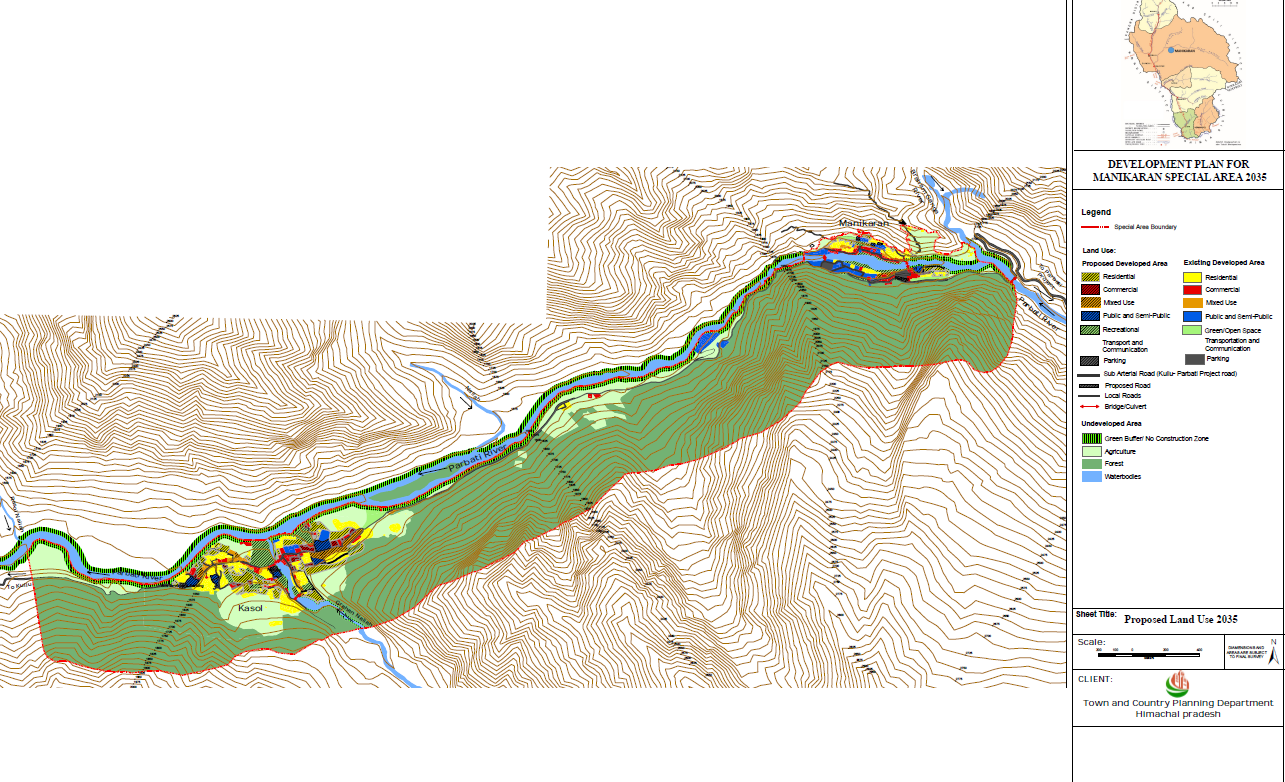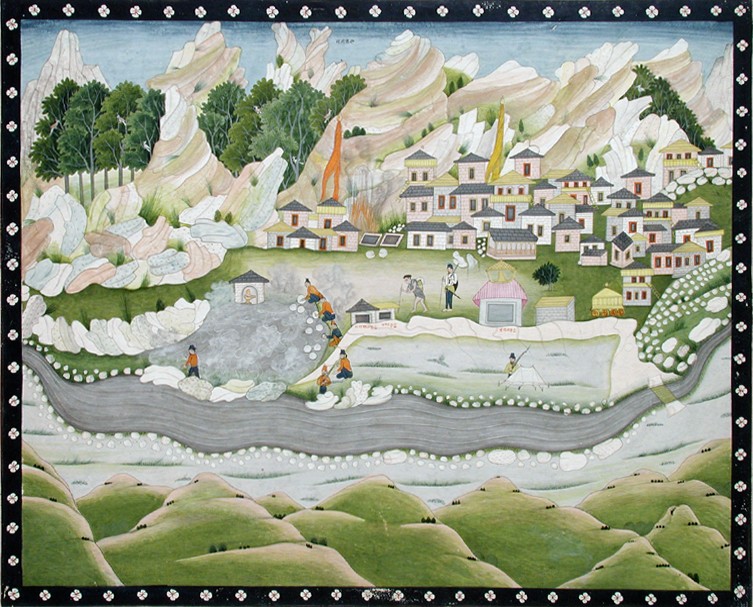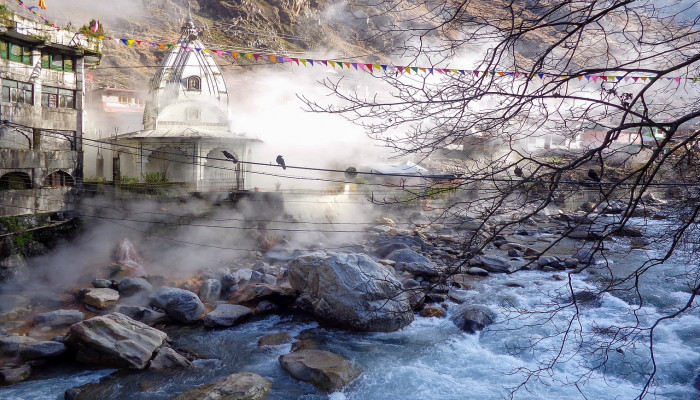Manikaran’s Sacred Hot Springs Under Threat: A Call to Preserve Faith and Heritage
- In Current Affairs
- 12:22 PM, Feb 24, 2025
- Rohit Pathania & Aryaman Sharma
Nestled in the Parvati Valley of Himachal Pradesh, Manikaran has long been revered as a sacred site by both Hindus and Sikhs. Its legendary hot springs—believed to have appeared when Bhagwan Shiva meditated in the region for millennia—are integral to the spiritual fabric of this holy town. For countless devotees, the thermal waters represent not just a marvel of nature but a divine gift that has held immense religious importance for centuries. Today, however, the sanctity of these waters hangs in the balance as government plans to divert the springs to a proposed eco-nature park threaten to undermine the very essence of Manikaran’s heritage.
Plans by the state government have recently become public knowledge to create an eco-tourism nature park in the nearby area of Grahan have sparked widespread concern. Reports suggest that the hot spring waters of Manikaran would be diverted through pipes spanning 4 kilometres to feed spa-like facilities in Kasol or Grahan. While eco-tourism can potentially bring more revenue and tourism to remote regions, the proposal to use these sacred waters for commercial therapy pools has alarmed locals and pilgrims alike.
As per the RFP document for this project, the initiative is part of a larger effort by the Forest Department, which has identified a few sites in the State to be developed as ecotourist sites according to the ecotourism principles as set out in the H.P. Eco-Tourism Policy, 2017. The project is supposed to be environmentally sustainable and promote environmental conservation, knowledge and understanding of nature, employment generation for local communities, and public awareness about environmental conservation and sustainable use of environmental resources.
However, contrary to the state policy’s objectives, the project’s intention of taking away water from hot springs will lead to interference in the ecological balance of the area. Manikaran has already seen environmental impacts from various infrastructure projects along the Parvati River. In 1999, Himachal Pradesh Tourism Development Corporation's (HPTDC) Parbati Hotel was washed away by floods in the river, and today the site has become a waste dumping yard. Heaps of garbage dumped there is an eyesore, especially considering the site’s proximity to key religious places, including the ancient Shivalaya, Naina Devi Temple and the Ram Temple. Any further tampering with its hot springs could irreversibly damage both the religious and natural landscape of the site.
Community representatives and religious custodians have submitted formal memorandum to district officials, urging the state government to abandon any plan that involves tampering with the Manikaran Springs. Citing the emotional, cultural, and religious significance of the hot waters, they demand a more respectful development approach—one that fosters economic growth without compromising the spiritual heart of Manikaran.
The government, however, has doubled down on the project despite local protests. Local Member of the Legislative Assembly Kuldeep Singh Thakur called it an attempt to play communal politics to stall development in the area. “'Some people in Kullu have been doing politics in the name of religion and this will not be tolerated at all in the matter of development. The general public has no opposition to the nature park being built in Grahan of Manikaran Valley of District Kullu. Some people are being instigated in this matter. Earlier also, many development plans were opposed in the name of religion, due to which the development of District Kullu has also suffered a lot, but when it comes to their own benefit, these people who opposed change the rules in the name of religion. Now this kind of politics will not be tolerated at all,' he told the media, in an apparent dig at former MLA and Kullu scion Maheshwar Singh and his role in the infamous Ski resort incident of 2006.
However, the absence of any project report and environmental impact assessment reports on the project in the public domain raises more questions about the government’s action plan. Hot water arises due to the presence of the groundwater, which was already impacted due to the damming of the Parvati River. Further extraction and transport through a 4km pipeline will not be easy - corrosion, mineral scaling and buckling due to the physical and chemical properties of water from hot springs means significant maintenance costs. This implies significant attention to detail when choosing the pipeline. Also, land subsidence, or sinking of the land surface, is sometimes caused by the removal of water from the existing geothermal reservoirs. Geothermal facilities address this risk by re-injecting wastewater back into geothermal reservoirs after the water’s heat has been captured - however, there is absence of information on the project right now.
Then there is also the problem of the feasibility of the project itself - the government of the state has been having problems in keeping hotels it owns afloat. In November 2024, the Himachal Pradesh High Court had ordered the closure of 18 hotels owned by HPTDC “to ensure that public resources are not wasted by the tourism development corporation in the upkeep of these white elephants.” What is also interesting to note is that the Eco-Park was never a part of the original Development Plan 2035 for Manikaran Special Area that was issued in 2016 by the Special Area Development Authority (SADA) of the region.

It must also be pointed out that despite numerous promises, local communities in Manikaran feel sidelined. As per the locals, existing schemes intended to improve the region such as SADA have not delivered tangible benefits, and residents fear that further commercialisation will only heighten these disparities. The lack of essential facilities such as sewerage system, public toilets and adequate parking spaces has become a pressing issue, particularly during the tourist season as per locals - a clear indication of the failure of the initiatives to achieve a significant positive outcome.
Himachal Pradesh has witnessed the unfortunate loss of sacred hot springs in the past. Tattapani, another revered site known for its healing geothermal waters, was irreparably altered when its hot springs were submerged following the Kol Dam hydroelectric project. The cultural and spiritual loss for the local community in the Shimla and Mandi districts was immense, as the site for the annual Makar Sankranti mela where the hot springs existed drowned under the Kol Dam’s catchment reservoir without any attempts for restoration or relocation. Many now worry that a similar fate could befall Manikaran if the government prioritises tourism revenue over preserving religious sanctity.
Manikaran: A Historical and Spiritual Haven
According to local tradition, Bhagwan Shiva’s intense meditation for thousands in the mountains led to the emergence of these hot springs, marking Manikaran as a place of unique spiritual energy.
Another legend has it that Bhagwan Shiva and Mata Parvati spent several years meditating here. During their stay, Mata Parvati lost her earring (mani) in the river. When Shiva ordered his attendants to retrieve it, the serpent god Sheshnag spewed hot water, causing the lost jewel to emerge from the depths. This event is said to have created the hot springs of Manikaran, and hence the name of the place.
Manikaran is equally significant to the Sikh community as one of the places Guru Nanak visited in his udasi's (sacred journeys), owing to this, a historic gurudwara stands by the hot springs even now. Devotees often use the geothermal water for cooking langar (community meals) and for sacred ablutions, viewing the continuous steaming pools as a manifestation of divine grace.
The hot water springs of Manikaran have been an integral part of the ongoing religious activities at the site for centuries now. The use of heat from the underground springs for cooking food for the pilgrims which is distributed as prasad, has been well documented. One such evidence of documentation is a painting from 1764, currently housed in the collection of the San Diego Museum of Art. The painting, made in Pahari style, shows cooking being done using the heat from the pool by temple officials in the vicinity of the local Shiva temple, underscoring the cultural and religious aspect of the practice that is ongoing to this day at the tirtha.

Another aspect of the tirtha is the fact that many deities of the locals have been brought to Manikaran for bathing in the warm waters during special festivals. This, again, as part of the Dev Samaj culture of the upper Himachal and Tons Valley stretching into Uttarakhand, is a practice that is part of the intangible cultural heritage of the Kullu valley that is very much alive to this day.
In 2024, Devta Bijli Mahadev, an extremely important deity of Kullu valley, descended for a shahi snan or royal bath, in an ongoing tradition. Besides, Bijli Mahadev, many other deities, Mata Parvati Chonj, Dev Paldi Chhamahu and countless other deities of the Kullu valley have been invoked for this ritual for centuries now.
Dev Bijli Mahadev | Mata Parvati | Shahi Snan |
Destruction of the hot springs and the natural water flow through a pipeline-based diversion will significantly disrupt these traditions, and also render the import of the rituals of the locals meaningless. Manikaran’s geothermal springs are not merely tourist attractions; they are central to centuries-old practices of devotion and spiritual submission. Converting them into commercial spa amenities disrespects the sacredness that devotees hold dear, and will be detrimental to the intangible cultural heritage of the culture of the Himalayan state, particularly the Kullu Valley.
A Plea for Preservation and the Road Ahead
The government’s current financial constraints do not justify encroaching on a sacred site of immense cultural and religious importance. In this regard, a petition cum signature campaign has also been launched online by concerned citizens to get the State government and Union Ministry of Culture to intervene and stop the diversion plans immediately and also address local concerns. A truly sustainable development plan would involve:
- Respecting Religious Sentiments: Any proposal impacting a site of worship should be vetted in close consultation with local religious authorities, temple committees, gurudwara management and community leaders.
- Protecting Natural Resources: Conservation of the hot springs must be paramount, ensuring that the ecological balance remains intact and that future generations can continue to experience the healing warmth and spiritual solace of Manikaran’s waters.
- Comprehensive Infrastructure Upgrades: Rather than diverting sacred resources, the government could focus on improving roads, water supply and tourist facilities around Manikaran itself—providing structured, culturally sensitive experiences for visitors and pilgrims.
- Transparent Governance: Authorities should publicly disclose any studies or plans to alter or divert natural resources. Engaging in open dialogue with residents and pilgrims fosters trust and aligns state interests with local sentiments.
Manikaran’s hot springs stand as a testament to Himachal Pradesh’s rich tapestry of faith, mythology, and natural splendour. While the promise of additional tourism revenue may be enticing, it cannot come at the cost of eroding spiritual heritage and natural wealth. The government has a responsibility to balance economic development with cultural and religious preservation, especially in places as sacred as Manikaran.
In this pivotal moment, concerned citizens and devotees are calling for the cessation of plans to redirect the hot springs, urging the state authorities to recognise that certain treasures cannot be replicated or replaced once lost.
Manikaran’s sacred waters are part of a legacy that transcends monetary gain; they symbolise faith, community and divine grace. It is imperative that all stakeholders—the government, local communities, and devotees—work together to ensure Manikaran remains a revered haven of devotion and not merely a commercial venture.
The sacred waters of Manikaran have been a wellspring of faith for centuries, revered for their divine origin and healing properties. Diverting these waters to a tourism park tantamount to treating a deeply venerated resource as a mere commodity. As calls grow louder for the Himachal Pradesh government to preserve this spiritual site, one thing is clear: the soul of Manikaran—and perhaps the very identity of Himachal’s spiritual heritage—hangs in the balance.
It is time for the government to recognise the gravity of the situation, halt any plans that threaten these sacred springs and restore public faith by protecting a legacy that belongs not just to Himachal, but to the nation as a whole.
Images provided by the authors.
Disclaimer: The opinions expressed within this article are the personal opinions of the author. MyIndMakers is not responsible for the accuracy, completeness, suitability, or validity of any information on this article. All information is provided on an as-is basis. The information, facts or opinions appearing in the article do not reflect the views of MyindMakers and it does not assume any responsibility or liability for the same.







Comments